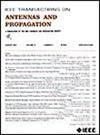Design, Theoretical Modeling, and Experimental Evaluation of Low-Frequency Self-Biased Magnetoelectric Mechanical Antennas
IF 5.8
1区 计算机科学
Q1 ENGINEERING, ELECTRICAL & ELECTRONIC
引用次数: 0
Abstract
This work presents the design, theoretical modeling, and experimental evaluation of low-frequency self-biased magnetoelectric mechanical (MEM) antennas. The thin magnet layer provides a self-biased magnetic field for achieving MEM antennas with a compact size and large radiation intensity. Bias magnetic field, nonlinear magnetostrictive (MS) effect, and the coupled longitudinal and bending modes are included in the theoretical model to accurately analyze self-biased MEM antennas. A novel self-biased MEM antenna with the bending cantilever mode is designed and optimized with the proposed theoretical model. A prototype of the proposed self-biased MEM antenna is fabricated. The self-biased MEM antenna exhibits an extremely compact size of低频自偏置磁电机械天线的设计、理论建模与实验评估
本文介绍了低频自偏置磁电机械(MEM)天线的设计、理论建模和实验评估。薄磁层提供了自偏置磁场,实现了尺寸紧凑、辐射强度大的MEM天线。在理论模型中考虑了偏置磁场、非线性磁致伸缩效应以及纵向和弯曲耦合模式,以准确分析自偏置MEM天线。利用所提出的理论模型,设计并优化了一种弯曲悬臂模式的自偏置MEM天线。制作了自偏置MEM天线的原型。自偏置MEM天线具有非常紧凑的尺寸,为8.2\ × 2\ × 0.39$ cm3。实验结果表明,所设计的自偏置MEM天线工作在356 Hz的超低频(ULF)频段,在1m的传输距离内能够产生110 nt的磁通密度。实测结果与数值结果吻合较好,验证了理论模型的准确性和有效性。该研究为自偏置MEM天线的建模和开发提供了理论框架,对需要低频远距离通信的应用具有吸引力。
本文章由计算机程序翻译,如有差异,请以英文原文为准。
求助全文
约1分钟内获得全文
求助全文
来源期刊
CiteScore
10.40
自引率
28.10%
发文量
968
审稿时长
4.7 months
期刊介绍:
IEEE Transactions on Antennas and Propagation includes theoretical and experimental advances in antennas, including design and development, and in the propagation of electromagnetic waves, including scattering, diffraction, and interaction with continuous media; and applications pertaining to antennas and propagation, such as remote sensing, applied optics, and millimeter and submillimeter wave techniques

 求助内容:
求助内容: 应助结果提醒方式:
应助结果提醒方式:


